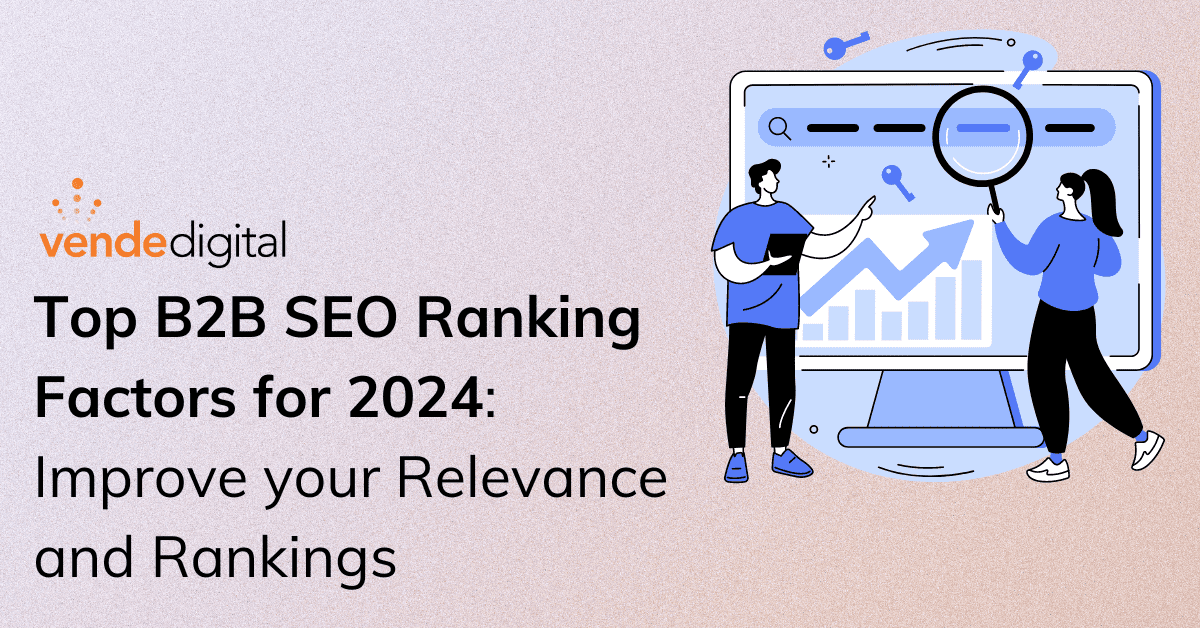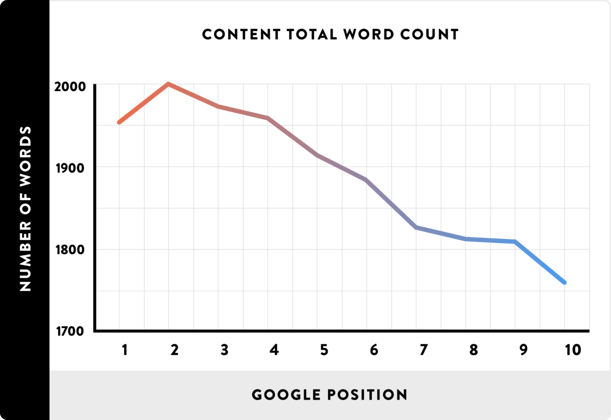
Top B2B SEO Ranking Factors for 2024
What’s Changing and What’s Staying the Same
This article will uncover the top B2B SEO ranking factors for improving your relevance and rankings in an evolving search landscape.
Google has over 200 SEO ranking factors, but five matter the most to B2Bs. SEO constantly changes, making it challenging to drive traffic, generate leads, and create a sales pipeline. It’s hard to get ahead because significant shifts like AI, SGE, and other search engine algorithmic changes come as soon as you have it all figured out.
In this article, we’ll cover what’s changing in SEO and what’s changing for B2B. The focus is on high return on effort activities to outrank your competitors. From elevating expertise and optimizing conversational queries to showcasing differentiation in rich search results, these strategic moves will help you improve visibility and overall performance.
Everyone Wants to Be at the Top of Google Search Results
Nearly 90% of B2B buyers will utilize a search engine at some point during their buying journey. We all want to be #1 on Google Search when buyers seek a solution like ours. However, high visibility in search engine results pages (SERPs) isn't just a matter of luck; it's the outcome of strategic focus and effort.
What are SEO Ranking Factors, and Why Are They Important?
SEO aims to get higher search engine rankings for your web pages, resulting in more traffic to your website. SEO ranking factors are elements that search engines use to determine a website's relevance and credibility. They are crucial in determining a website's position in search engine results pages (SERPs). A comprehensive SEO strategy should consider these factors because ignoring them could significantly impact visibility, clicks, and conversions.
What are the Most Important B2B SEO Ranking Factors for 2024?
Imagine B2B Search Engine Optimization as building and maintaining a bustling city. Like urban planning, B2B SEO requires a strategic approach to create a thriving digital environment.
- The first step is constructing high-quality infrastructure, which, in SEO terms, means creating valuable, engaging, high-quality content to attract and retain visitors.
- Then, we need a well-thought-out city plan that translates into a well-structured site architecture and sound technical SEO to ensure easy navigation for users and search engines.
- Signposts guide people around the city, just as keywords guide search engines to your content. Proper keyword optimization is crucial for search engines to understand and match your content with relevant search queries.
- Next, we build bridges and roads, or in the digital realm, we build links to and from other websites, increasing our visibility and authority.
- Lastly, we integrate innovative technology, like AI in SEO, to identify trends, automate tasks, and provide insights, enhancing our overall strategy and efficiency.
We recently held a Demand Gen Jam Session with B2B SEO expert Jesse McFarland to discuss the top B2B SEO ranking factors for 2024. You can watch the replay here or read on to explore each ranking factor in detail, with specific examples and tips.
1. Improve Your Content Quality and User Experience
Just as well-maintained parks and public spaces enhance a city's livability, creating high-quality, engaging content enriches your website, attracting visitors and encouraging them to stay longer.
That’s why creating high-quality, valuable content is at the top of this list of Google ranking factors. High-quality content improves user experience and increases your website's chances of ranking higher in search results. Why? Because search engines prioritize content that is relevant, informative, and engaging for users.
- Ensure Your Content is Thorough, Useful, & Unique: Google wants content that fully answers a user's query and satisfies their search intent. For instance, if someone searches for "Demand Generation Best Practices," an article with specific tips on how to get started with demand generation would be more valuable than an opinion piece on why demand generation is better than lead generation. However, uniqueness also matters. If your post simply regurgitates information already out there, it's unlikely to rank well on Google. This is because Google has already indexed content with the same information. To improve the quality of your content, it must be unique and offer more value than what's already available.
- Structure for Scannability & Mobile First: Most visitors will only read part of your article. They tend to skim through it first and focus on the sections that catch their attention. To make your content easy to scan, use multiple headers, bullet points, and bolded phrases. Additionally, check your content on a mobile device to ensure that it's also easy to scan on smaller screens.
- Rich Media Integration: People don’t just read the internet; they want to watch and listen to it. Include charts, videos, and infographics to supplement your content. The more unique to your business or the topic at hand, the better. However, don’t overthink it. A simple screenshot of a slide in a slide deck or of your product can make a big difference. Always use descriptive file names and alt text for better SEO.
- Improve Content-Length and Depth: Long content is good for SEO. Aim for 1,500-2,500 words for blog posts. Improve the depth of your content by including statistics, case studies, and real-life examples. This adds credibility and value to your content, making it more likely to be shared and linked to by others. But length also depends on content goals, audience needs, and search intent. Your first objective should be thoroughly answering your audience's questions and understanding their needs.

Source: Backlinko
- Include Key Takeaways: Make it easier for readers to digest your quality content by including key takeaways at the end of each section. This also helps with scannability and retention of information (see example at the end of this blog).
Pro Tip - Quality Content Ranking Factors: Look for unique angles not covered by your competition and move from a “how to” to a “how we” writing style. Check out our blog, 8 Essential B2B Blogging Tips, for more advice.
2. Improve Your Site Architecture and Technical SEO
Just as a city's infrastructure supports transportation and communication, a website's architecture and technical SEO facilitate smooth navigation and accessibility for users and search engines.
According to Google, slow-loading, difficult-to-crawl, and unsecured websites won’t rank well, making technical SEO one of the most important Google ranking factors. However, Google doesn’t keep us in the dark on what to address regarding technical SEO. They provided resources to analyze and enhance performance when they rolled out Core Web Vitals into their ranking algorithm. Follow these tips to improve your site's technical performance and rank higher in search results.
- Accelerate Load Times: Many factors impact load times, including image sizes, web hosting, and redirects. Leverage Google Page Speed Insights to evaluate overall site health and to diagnose the specific elements dragging down your website’s performance. (see same report below)
- Tackle Indexing Issues: To keep your website's quality content visible to search engines, address any indexation issues, such as broken links, duplicate content, or missing alt tags. Use Google Search Console to monitor the status of your indexing, submit sitemaps, and view reports and insights on your search performance. Troubleshoot any indexing issues, such as duplicate content or blocked resources.
- Utilize Structured Data: Implementing structured data can provide additional context to search engines about the content on your website. This can lead to rich snippets in search results, making your website stand out and potentially increasing click-through rates. Structured data also helps with indexing and crawling, ultimately improving your overall SEO efforts.
- Fix Broken Links: They're more than mere annoyances; they're barriers to a smooth user journey and keep search engines from crawling your website. Use tools like Google Search Console or SEMRush to identify and fix broken links on your website.
- Optimize Images: Images can enhance the visual appeal of your website and provide valuable information. However, large or unoptimized images can slow your website's loading speed, negatively impacting user experience. Compress images, include keywords in file names, and use alt tags for better accessibility and SEO.
- Build Internal Links Using the Hub & Spoke Framework: Interlinking related web pages using the Hub & Spoke framework can significantly benefit your website's SEO and user engagement. The "Hub" pages provide a comprehensive overview of a pillar topic, while the "Spoke" pages delve into related subtopics, linking back to the hub. This approach increases the authority of the hub page and provides users with a pathway to more detailed information, improving their experience and conversion rates.
- Improve Title Tags & Descriptions for Higher Clickthrough Rates - Improve website traffic by boosting clicks, not just search rankings. Your page titles significantly impact clicks because they’re in the link displayed in search results. It’s crucial to craft titles that grab attention and entice people to click.
- Include Keywords in Your URL - Google analyzes webpage URLs to comprehend the page's content. Many websites are built on WordPress CMS, automatically generating a URL from the page title. This automated process often results in an excessively long URL. Be sure to shorten the URL as much as possible and make sure it incorporates the primary keyword or phrase.
Pro Tip - Technical SEO Ranking Factors: Leverage AI tools to help update your title and description tags to include a call to action for improved click-through rates. You can also use AI to build schema for structured data.
3. Keyword Optimization for Search Engines
One of the oldest Google ranking factors is keyword optimization, and optimizing for targeted keywords and phrases is a lot like street signs and maps that guide visitors through a city. Effective keyword optimization helps search engines and users navigate your content, ensuring they find precisely what they want.
You must research and strategically use keywords your target audience searches for while avoiding "keyword stuffing" that can harm your rankings. Google has made enormous strides in understanding user search intent and identifying over-optimized web pages. Follow these tips for proper keyword optimization.
- Optimize for Natural Language, Not Just Key Words: Natural Language Processing (NLP) is part of Google's BERT algorithm that understands the context of a search query, not just keywords. To use NLP in SEO, include natural language phrases and related terms for complete topical coverage. The goal should be to comprehensively cover all aspects of a topic so you can fulfill user needs and avoid the need for the user to look to additional sources. Use tools like Ubersuggest, SEMRush, or AI-powered assistants like Jasper to find relevant NLP-based keywords.
- Use Long-Tail Keywords: These are longer and more specific phrases, making them less competitive but potentially more valuable. Long-tail keywords often reflect natural language phrases used in conversational queries and can help you rank higher for niche topics. They're also easier to rank for than general keywords. For example, instead of targeting this article for "SEO tips," we are optimizing it for “B2B SEO Ranking Factors.”
- User Search Intent: Aligning your content with the four primary search intents - informational, navigational, transactional, and commercial investigation - can increase engagement, conversion rates, and customer acquisition. Match your content to the user's search intent to pique their interest.
- Optimize for Answers to Questions: With the rise of featured snippets in Google search results, users are increasingly looking for quick and easy answers to their queries. Add FAQs on relevant topics to your content. This provides comprehensive coverage and answers user queries. Search engines often feature FAQ snippets in Google search results, giving you a chance to appear on top. Use question-based keywords like "how to" or "what is" in your content titles and body to optimize for voice search.
Pro Tip - Keyword Optimization Ranking Factors: Use AI to Help Build a Key Phrase-Rich Data-Driven Content Plan. Watch the video below and grab the instructions in our AI Marketing Toolkit. Following the instructions will produce blog topics, key phrases, featured Q&A snippets, and E-E-A-T instructions. In just 60 seconds, you will have a 12-month content plan to hand off to your content team.
4. Build and Distribute Linkable & Referable Content
Creating linkable and referable content is akin to a city's iconic landmarks that visitors are eager to photograph and share with others. Backlinks from credible sites enhance your website's reliability in the eyes of search engines. This is because backlinks are considered a vote of approval from other websites, signifying that your content is valuable. While creating backlinks, prioritize quality over quantity and abstain from spammy or paid tactics that could harm your reputation.
- Linkable Assets: Create linkable assets (checklists, guides, tip sheets, templates, original research, etc.) to attract backlinks to your website. Valuable content like this will often get linked to by others in their content. The key is to avoid being too promotional so that others will be willing to link to your assets.
- Build a Content Flywheel: Repurposing content into various other formats like video tutorials, Slideshares, and carousels can amplify your reach and increase the chances of earning backlinks. Sharing your content on different platforms opens up opportunities for others to discover it and link back to it. In the example below, we convert the content from our monthly Demand Gen Jam Sessions into multiple assets (blogs, long/short-form videos, guides, playlists, etc.)
- Collaborate with Influencers: Partner with other influencers in your industry to create content together. This will bring more visibility to your brand and earn you quality backlinks. When an influencer shares or mentions your content, it can drive traffic and improve your Google search engine rankings.
- Guesting on Relevant Podcasts: Collaborating with other influencers or industry experts by appearing as a guest on their podcasts can be a great way to reach a new audience and earn relevant backlinks. Most podcasts have show notes on their website, which can give you a backlink to your site. This will help you build backlinks and establish your expertise in your field.
- Build Top 10 Lists as EgoBait: EgoBait refers to a type of content that aims to flatter and attract the attention of a specific individual or group in the hopes of gaining backlinks. One effective way to create EgoBait is by publishing Top 10 lists that feature top influencers or companies around a particular topic. After publishing the list, let the folks on the list know. This may lead to them sharing your content on their channels.
Pro Tip - Link Building Ranking Factors: Besides earning backlinks, regularly monitor and audit existing ones. Make sure they are still relevant and coming from authoritative sources. If you find any low-quality or spammy backlinks, take action by disallowing them.
5. Drive Experience, Expertise, Authority and Trust (E-E-A-T)
Just as a city's reputation is built on its history, safety, and attractions, your website's credibility grows through demonstrating Experience, Expertise, Authority, and Trustworthiness (E-E-A-T), making it a go-to destination for information.
Unlike other SEO factors, Google evaluates E-E-A-T holistically, so you should look for ways to demonstrate credibility across your entire web presence, including websites, social media, review sites, and other third-party sites. Leverage your unique experience and expertise while highlighting external authority to demonstrate relevance and trustworthiness to users and Google.
Experience refers to the backstory and journey related to your business and first-hand experiences that inform your content. Expertise includes your team's professional qualifications, education, training, years in business, awards, and milestones demonstrating expertise. Authority refers to links, featured mentions, and testimonials from readers and the industry. Trust includes elements like contact information, certifications, satisfaction guarantees, and other factors that convey legitimacy.
Follow these tips to optimize your content for E-E-A-T:
- Share Your Story: One of the most effective ways to showcase your experience is by sharing your unique story. This can include how you started your business, any challenges or obstacles you have overcome, and what motivates you to do what you do. Personal anecdotes and real-life examples help to humanize your brand and make it relatable to users.
- Create Author Pages: One effective way to showcase your expertise is by creating author pages on various platforms. These pages allow you to provide a brief bio and links to your other work, helping readers better understand your SMEs and what they offer. Check out the byline link in this article for an example.
- Link to Credible Sources: Linking to sources when citing statistics or expert viewpoints adds credibility to your content and establishes trust with readers.
- Develop Content Pillars: Develop 3-5 key themes that align with your brand and consistently create content around those topics. This can be through blog posts, social media updates, webinars, or podcasts. By focusing on a few core areas, you can become known as an expert in those topics and build a loyal following of readers who come to you for valuable insights.
- Active Participation in Relevant Conversations: Engage with your audience and actively participate in industry conversations. This could mean joining online forums or groups related to your field, answering questions on Quora or Reddit, hosting a community, or conducting Q&A sessions on social media platforms such as Twitter or LinkedIn. Not only does this help establish yourself as a leader in your industry, but it also allows you to gather feedback and insights from your target audience.
- Be a Consistent Voice: Consistency is crucial in building a solid content strategy. This means regularly publishing new content and sticking to a schedule that works for you and your audience. Consistently posting content helps keep your followers engaged and improves your Google search engine rankings.
Pro Tip - E-E-A-T Ranking Factors: Consider introducing.
- Contributor spotlights showcasing author backgrounds
- Behind-the-scenes company perspectives on industry issues
- Build customer use cases and success stories
- Highlight badge awards earned through partners or review platforms
- Share behind-the-scenes perspectives from real company experts
- Publish regularly to establish thought leadership
- Publishing series for deeper investigation of popular topics
- Highlight key differentiators and social proof
- Provide Continuing Education in Emerging Trends
Dominate Ranking Factors by Carefully Infusing AI Into The Mix
AI can be a powerful tool to enhance and expedite content ideation and creation. However, don’t rely too heavily on AI-generated blogs for SEO, as they often lack originality and nuanced messaging, ultimately undermining their usefulness to readers. When content fails to serve readers, it also fails to rank well. To responsibly harness AI, adhere to these best practices:
- Generate Ideas and Suggestions: AI tools can generate topic ideas based on popular search queries or trending topics. They can also provide recommendations for improving the structure and flow of your content. AI-inspired ideas can be beneficial when your team experiences writer's block or struggles with organizing their thoughts.
- Use AI for Research: Using AI to collect and analyze data can provide valuable insights to enhance your writing without compromising originality and quality. AI can serve as a research assistant, enabling you to locate reliable sources and statistics quickly. Moreover, it can assist in fact-checking and verifying information, saving time and effort for the writer.
- Use AI to Repurpose Content: One of the top ways we use AI is by taking transcripts from webinars, podcasts, and sales calls to ideate and create new blog content. It’s also very good at converting blog content into social media posts.
- Keep Content Fresh by Updating Older Content: Repurpose aging evergreen content using AI to incorporate fresh statistics, examples, and links. The new facelifted content will attract readers and search attention. This keeps your content relevant and boosts its ranking potential on search engines. Shift some blog production capacity from new content to refreshing/updating older, outdated, high-impression posts to increase clicks and conversions.
- Analyze Previous Content Performance Data to Reveal Gaps: AI helps identify topics that are underrepresented or high-performing keywords missing in your content.
- Develop Content Briefs and Initial Drafts for Enhanced Topical Coverage: AI can help create outlines, briefs, and initial drafts for writers to follow. This ensures that all necessary topics and keywords are included while allowing creative freedom in the writing process.
- Leverage AI Tools to Improve SEO and Grammar: AI tools can assist with key phrase selection, key phrase coverage, analyzing competitor pages that rank well, and improving sentence structure, grammar, and syntax. This helps ensure your content is optimized, grammatically correct, and flows smoothly for readers.
- Create Audio Versions of Your Content: Leverage AI tools like Murf.ai to convert written content into audio versions. You can transform blog posts into spoken content and optimize for voice search. Check out this blog article for an example of AI-generated audio.
See Better and Do More by Monitoring Google Ranking Factors
Staying ahead in B2B SEO requires recognizing when to change course and when to hold. This requires a commitment to monitor and optimize your online presence. Follow these tips to turn data into actionable insights that drive B2B SEO improvements and growth.
- Establish Benchmarks and Priorities: Leverage analytics platforms like GA4 to set targets for key conversion events. Define optimal Google search visibility levels. Identify and diagnose underperforming areas to focus optimization efforts.
- Monitor Metrics Tied to SEO Value: Closely track website visitors, leads, rankings, and other KPIs tied to organic performance. Connect the dots between SEO activities and actual ROI impact.
- Perform Routine Technical SEO Audits: Frequently audit on-page elements – titles, URLs, structured data, etc. Fix issues to maintain a technically sound presence.
- Optimize Based on Real User Signals: Beyond vanity metrics, incorporate behavioral signals like scroll depth or time on the page. Identify your best content, and double down on what resonates with your audience.
- Proactively Fix Content Gaps: Leverage AI tools to reveal missing or ineffective pages aligned to user intent. Create comprehensive content coverage to attract search traffic.
- Stay Ahead of Algorithm and Platform Shifts: Monitor updates from Google to preemptively realign strategies to changes that impact organic visibility and traffic.
Ranking Factors Pro Tip: Leverage Google Search Console's Enhanced Pages report to reveal optimization opportunities—sort pages by ranking position and CTR. Analyze lower traffic pages to identify specific on-page elements hurting performance. Make surgical enhancements to queries and content, delivering the highest ROI. Monitoring metrics per page allows incremental gains that compound over time for sustained organic growth.
Tying the Top B2B SEO Ranking Factors Together
Remember to connect your SEO efforts with aligned content, social, and paid campaigns to activate your audience and get your information in places where your customers go to learn. Why? Your website does not exist in a vacuum. Optimization around searcher intent should permeate messaging across all channels.
Strive for agility but with a strong spine built upon remarkable content and user needs as your guide.
Remember, Google primarily focuses on whether your content provides value to users and adheres to its Search Essentials (formerly Webmaster Guide) to gather feedback and insights. For content to rank well, it must be:
- High-quality
- Relevant
- Unique
- Easy to read
- Informative
- Well-written
- Not stuffed with keywords
- Effectively answer user queries
B2B SEO Ranking Factors Key Takeaways
As Google's AI search advances and the online content landscape grows more crowded, the top B2B SEO ranking factors to improve your search results are:
- Optimizing for Google's new Search Generative Experience (SGE) interface with concise, visual content formatted as questions and answers.
- Carefully using AI tools to enhance human-written content while ensuring uniqueness and author expertise/authority.
- Strengthening website technical SEO with faster load speeds, internal linking structures, and mobile responsiveness.
- Incorporating conversational long-tail keywords and natural language aligned to searcher intent.
- Establishing domain authority and earning high-quality backlinks through share-worthy content assets and guest posting.
B2B marketers must be like savvy city planners who continuously optimize infrastructure and adopt innovations. To retain visibility, they must stay focused on SEO evolutions. As Google's algorithms get smarter and competition for rankings amplifies, what worked last year may not work this year. However, companies that relentlessly build remarkable content, elevate expertise, and tackle technical challenges will stand apart from their competitors.
How Can We Help
Do you need help with optimizing your B2B website for search engines? If your current SEO strategies are not yielding the desired results and your competitors are outranking you, we can help. Our SEO Roadmap identifies the gaps in your optimization efforts and provides structured improvements that align with your goals. Let's connect if you're looking for data-driven SEO that can drive pipeline influence and sales velocity.







